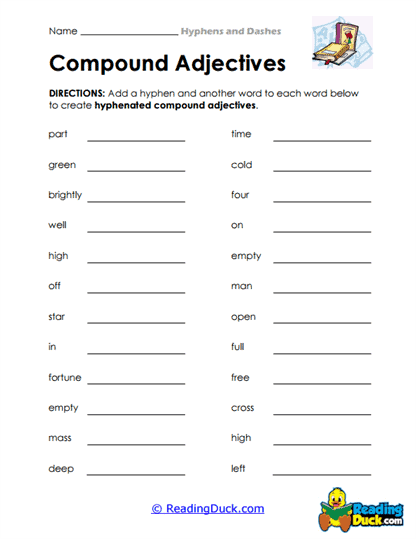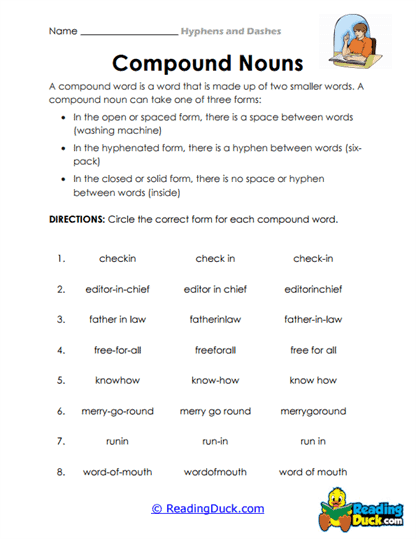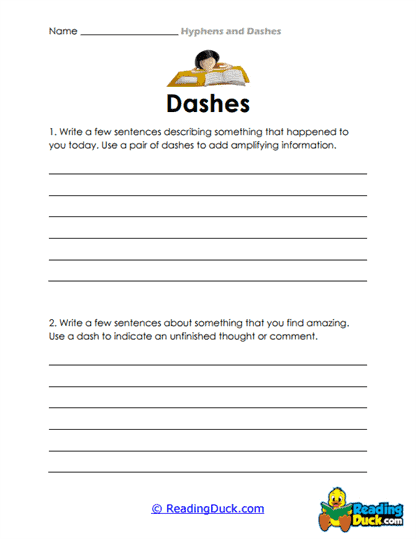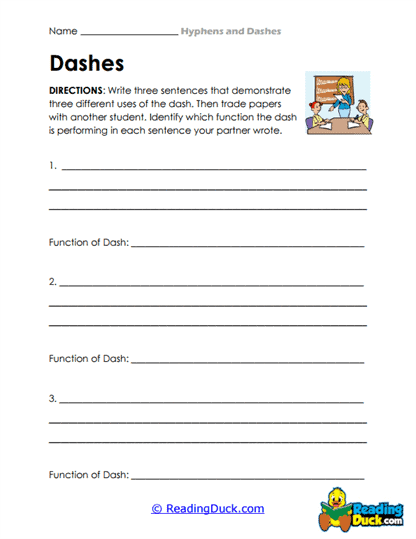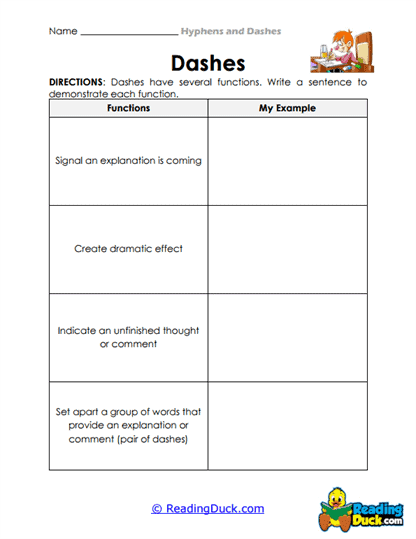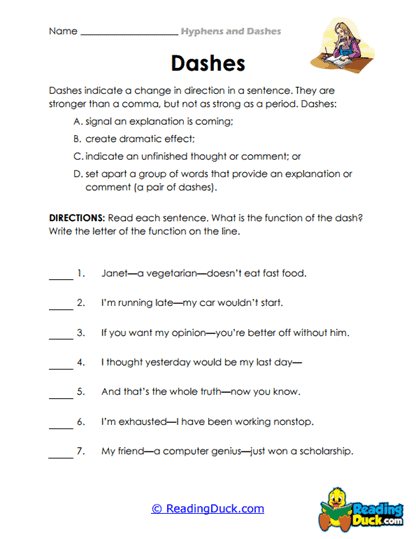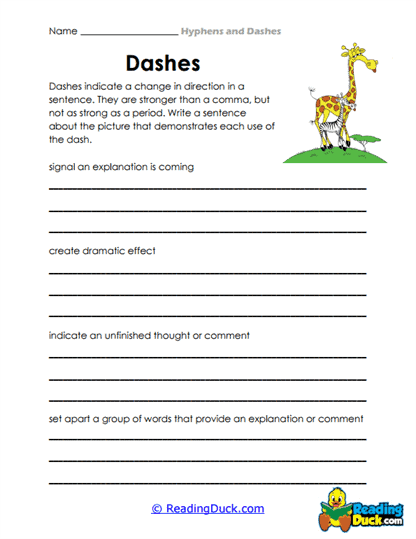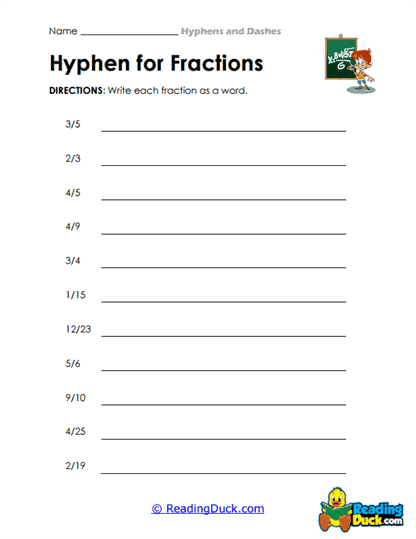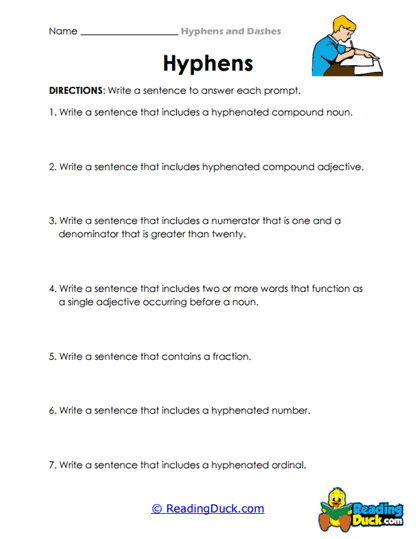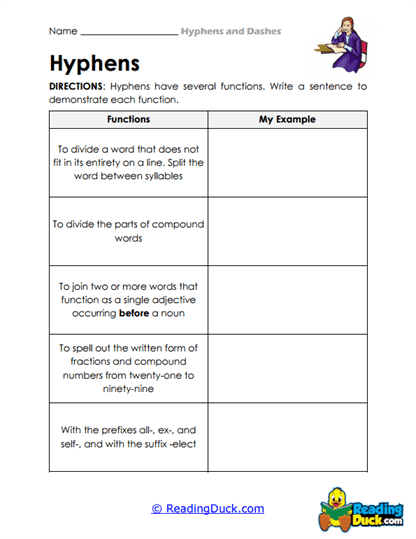Hyphens and Dashes Worksheets
About Our Hyphens and Dashes Worksheets
Our collection of Hyphens and Dashes Worksheets provides an in-depth resource for students to develop a strong understanding of these essential punctuation marks. Falling under the Punctuation category within the Skills section, this collection is designed to help learners master the differences and correct uses of hyphens and dashes, enhancing their writing clarity and precision. Hyphens and dashes play a crucial role in connecting words and ideas, as well as adding emphasis and structure to writing.
The worksheets are presented in PDF format, making them simple to view, download, and print for convenient use in both classroom and homeschool settings. Additionally, each worksheet includes a downloadable answer key, allowing students to check their work independently while also providing educators with a quick and easy way to assess progress. This format ensures an accessible and effective learning experience for all.
Hyphens and Dashes: An In-Depth Exploration
Hyphens and dashes may appear similar at first glance, but they serve very different purposes in writing. Both punctuation marks are used to connect ideas and provide structure, yet their applications are distinct. Understanding these differences is crucial for writing fluently and accurately.
What Is a Hyphen?
A hyphen (-) is a short punctuation mark used primarily to join words or parts of words together. It serves to avoid ambiguity, clarify meaning, or create compound words. The hyphen helps writers maintain clarity and precision, especially when dealing with compound adjectives or numbers.
Common Uses of Hyphens:
Compound Words: Hyphens connect two or more words that function together as a single concept or unit.
-
- Example: well-known author, long-term project
Numbers and Fractions: Hyphens are used to write numbers between twenty-one and ninety-nine and fractions that function as adjectives.
-
- Example: thirty-three people, two-thirds majority
Word Breaks at Line Endings: When a word is too long to fit at the end of a line, a hyphen is used to divide the word, carrying part of it to the next line.
-
- Example: The meeting was held at a presi- dential palace.
What Is a Dash?
A dash comes in two main forms: the en dash (–) and the em dash (—). Dashes are longer than hyphens and have more flexible uses in writing, often for creating emphasis or interruption within sentences. The en dash and em dash have distinct roles, though both are used to add clarity and flow to writing.
En Dash (–): Slightly longer than a hyphen, the en dash is used to indicate ranges or connections between values.
-
- Example: The event runs from 10:00 AM–2:00 PM.
Em Dash (—): The em dash is longer and is often used in place of commas, parentheses, or colons to create a stronger break in a sentence or to insert additional information or emphasis.
-
- Example: The dog—a large, fluffy golden retriever—barked loudly.
Understanding the differences between hyphens and dashes, and knowing when to use each, ensures that students can write with greater clarity and control.
The Different Roles of Hyphens and Dashes in Writing
Hyphens and dashes each have specific functions that make them essential tools for clear and effective writing. Let’s explore the different uses of these punctuation marks and how they improve sentence structure and meaning.
1. Hyphens in Compound Modifiers
One of the most common uses of hyphens is in compound modifiers—when two or more words work together to describe a noun. The hyphen helps link these words so that the reader understands they function as a single unit.
- Example: The quick-witted child answered every question.
Without the hyphen, the sentence might be confusing. Is the child quick and witty, or quick-witted? The hyphen ensures clarity by indicating that "quick-witted" is one idea.
2. Hyphens in Numbers and Fractions
Hyphens are essential when writing numbers between twenty-one and ninety-nine, as well as fractions that are used as adjectives.
- Example: She won a thirty-two-mile race.
- Example: The recipe requires one-third of a cup of sugar.
In these cases, the hyphen ensures that the reader interprets the numbers and fractions correctly within the context of the sentence.
3. En Dashes for Ranges and Relationships
The en dash is often used to show ranges of numbers, dates, or other values. It acts as a bridge between two things that are connected in some way, such as a time span or a geographical relationship.
- Example: The concert will take place June 10–15.
- Example: The Boston–New York train line is popular among commuters.
The en dash creates a smooth connection, signaling that the two elements it joins are part of a range or relationship.
4. Em Dashes for Emphasis and Interruption
The em dash is a versatile punctuation mark used to add emphasis, mark an abrupt change in thought, or insert additional information. It is often seen as more forceful than a comma, and it helps break up sentences to add dramatic effect.
- Example: He was determined—no matter the cost—to complete the project.
- Example: She found the letter—hidden beneath the old book—after all these years.
In these examples, the em dash draws attention to the additional information, allowing the writer to create a pause or emphasis that changes the rhythm of the sentence.
The Importance of Hyphens and Dashes in Literacy Development
Learning to use hyphens and dashes correctly is an essential part of developing strong literacy skills. These punctuation marks play a key role in enhancing writing fluency, helping students convey their ideas more clearly and precisely.
Improving Writing Clarity and Precision
Hyphens and dashes help structure sentences in ways that make the meaning clearer and more direct. By mastering the use of these punctuation marks, students can avoid ambiguity and ensure that their writing is easy to understand. This ability to create well-structured sentences improves the overall quality of their communication.
Enhancing Reading Comprehension
Understanding the function of hyphens and dashes in a text also improves reading comprehension. When students encounter these punctuation marks in reading materials, they can better grasp the connections between ideas, understand time ranges, or follow the emphasis added by an em dash. Learning to interpret these marks in context strengthens their ability to process written information efficiently.
Developing Sophisticated Writing Techniques
Hyphens and dashes are tools that allow for more nuanced writing. As students grow in their writing abilities, using these punctuation marks enables them to write more sophisticated, polished sentences. Whether linking words with a hyphen or adding emphasis with an em dash, students can learn to express themselves with greater style and variety.
Engaging Activities to Reinforce Hyphens and Dashes Usage
To help students become more familiar with hyphens and dashes, educators can introduce a variety of activities that encourage hands-on practice. These activities can be adapted for various grade levels, offering opportunities for interactive and engaging learning.
Suggested Activities for Elementary and Middle School Students
- Hyphen Connection Game: Provide students with a list of compound words or phrases that need hyphens, and have them match the words to create the correct compound terms. This activity helps reinforce the rules of hyphen usage in compound modifiers.
- Create a Timeline Using En Dashes: Ask students to create a timeline of historical events, using en dashes to indicate the time range for each event. This exercise familiarizes students with the use of en dashes for ranges and helps them understand the connections between dates and events.
Suggested Activities for High School Students
- Dramatic Writing with Em Dashes: Encourage students to write a short story or dialogue that incorporates em dashes for dramatic effect. This activity helps students experiment with pacing and emphasis in their writing, learning how to use em dashes to create interruptions or shifts in tone.
- Hyphen Challenge: Present students with a series of sentences missing hyphens and ask them to add hyphens where needed. This teaches students to apply hyphenation rules and enhances their understanding of how hyphens impact sentence clarity.
Homeschool Activities
- Daily Life with Hyphens: Have students write a paragraph about their daily routine, using hyphens to describe compound activities or objects (e.g., after-school practice, high-energy snack). This makes learning about hyphens relatable and relevant to their everyday experiences.
- En Dash Exploration: Ask students to list various connections in their lives, such as sibling age ranges or distances between cities, and write them using en dashes. This helps them practice applying en dashes to real-world scenarios.
Hyphens and Dashes: A Vital Skill for Writing
In conclusion, hyphens and dashes are essential tools in writing that help connect words and ideas, clarify meaning, and add emphasis or structure to sentences. The Hyphens and Dashes Worksheets collection provides students with valuable practice in understanding the differences between these punctuation marks and applying them correctly in various contexts.
By mastering hyphens and dashes, students enhance their ability to write with precision, communicate complex ideas more clearly, and add sophistication to their writing style. This skill not only improves academic writing but also prepares students for effective communication in their future personal and professional lives. Understanding how and when to use hyphens and dashes ensures that students can express their ideas accurately, contributing to their overall literacy development and writing confidence.
